Luke Zettlemoyer
University of Washington
Reconstruction Alignment Improves Unified Multimodal Models
Sep 08, 2025Abstract:Unified multimodal models (UMMs) unify visual understanding and generation within a single architecture. However, conventional training relies on image-text pairs (or sequences) whose captions are typically sparse and miss fine-grained visual details--even when they use hundreds of words to describe a simple image. We introduce Reconstruction Alignment (RecA), a resource-efficient post-training method that leverages visual understanding encoder embeddings as dense "text prompts," providing rich supervision without captions. Concretely, RecA conditions a UMM on its own visual understanding embeddings and optimizes it to reconstruct the input image with a self-supervised reconstruction loss, thereby realigning understanding and generation. Despite its simplicity, RecA is broadly applicable: across autoregressive, masked-autoregressive, and diffusion-based UMMs, it consistently improves generation and editing fidelity. With only 27 GPU-hours, post-training with RecA substantially improves image generation performance on GenEval (0.73$\rightarrow$0.90) and DPGBench (80.93$\rightarrow$88.15), while also boosting editing benchmarks (ImgEdit 3.38$\rightarrow$3.75, GEdit 6.94$\rightarrow$7.25). Notably, RecA surpasses much larger open-source models and applies broadly across diverse UMM architectures, establishing it as an efficient and general post-training alignment strategy for UMMs
MetaCLIP 2: A Worldwide Scaling Recipe
Jul 29, 2025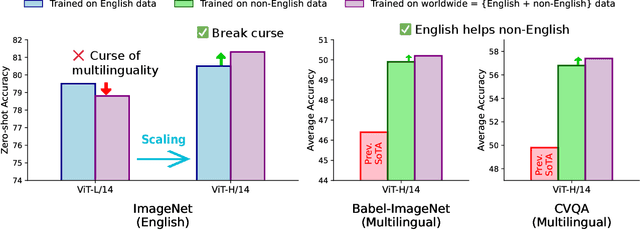

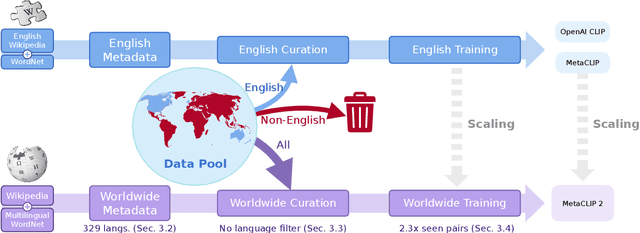

Abstract:Contrastive Language-Image Pretraining (CLIP) is a popular foundation model, supporting from zero-shot classification, retrieval to encoders for multimodal large language models (MLLMs). Although CLIP is successfully trained on billion-scale image-text pairs from the English world, scaling CLIP's training further to learning from the worldwide web data is still challenging: (1) no curation method is available to handle data points from non-English world; (2) the English performance from existing multilingual CLIP is worse than its English-only counterpart, i.e., "curse of multilinguality" that is common in LLMs. Here, we present MetaCLIP 2, the first recipe training CLIP from scratch on worldwide web-scale image-text pairs. To generalize our findings, we conduct rigorous ablations with minimal changes that are necessary to address the above challenges and present a recipe enabling mutual benefits from English and non-English world data. In zero-shot ImageNet classification, MetaCLIP 2 ViT-H/14 surpasses its English-only counterpart by 0.8% and mSigLIP by 0.7%, and surprisingly sets new state-of-the-art without system-level confounding factors (e.g., translation, bespoke architecture changes) on multilingual benchmarks, such as CVQA with 57.4%, Babel-ImageNet with 50.2% and XM3600 with 64.3% on image-to-text retrieval.
FlexOlmo: Open Language Models for Flexible Data Use
Jul 09, 2025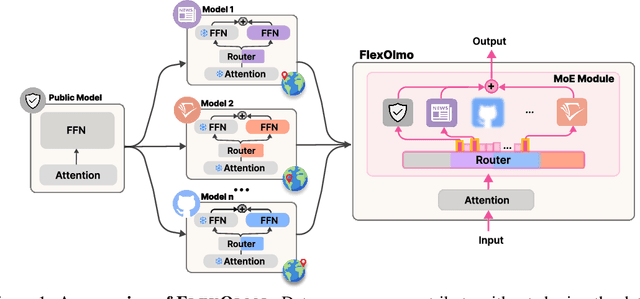
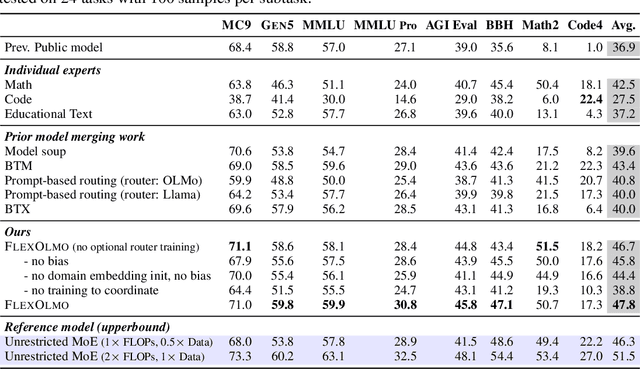
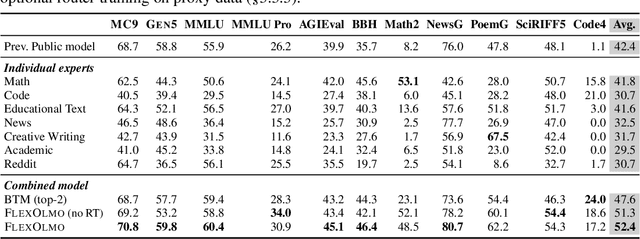
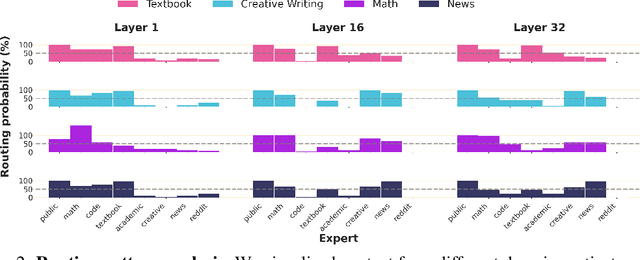
Abstract:We introduce FlexOlmo, a new class of language models (LMs) that supports (1) distributed training without data sharing, where different model parameters are independently trained on closed datasets, and (2) data-flexible inference, where these parameters along with their associated data can be flexibly included or excluded from model inferences with no further training. FlexOlmo employs a mixture-of-experts (MoE) architecture where each expert is trained independently on closed datasets and later integrated through a new domain-informed routing without any joint training. FlexOlmo is trained on FlexMix, a corpus we curate comprising publicly available datasets alongside seven domain-specific sets, representing realistic approximations of closed sets. We evaluate models with up to 37 billion parameters (20 billion active) on 31 diverse downstream tasks. We show that a general expert trained on public data can be effectively combined with independently trained experts from other data owners, leading to an average 41% relative improvement while allowing users to opt out of certain data based on data licensing or permission requirements. Our approach also outperforms prior model merging methods by 10.1% on average and surpasses the standard MoE trained without data restrictions using the same training FLOPs. Altogether, this research presents a solution for both data owners and researchers in regulated industries with sensitive or protected data. FlexOlmo enables benefiting from closed data while respecting data owners' preferences by keeping their data local and supporting fine-grained control of data access during inference.
Spurious Rewards: Rethinking Training Signals in RLVR
Jun 12, 2025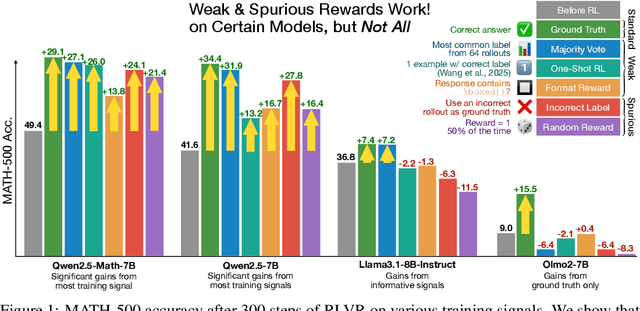


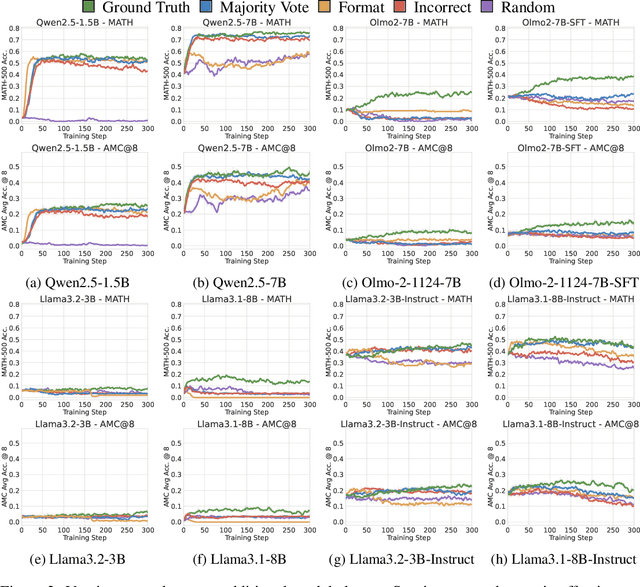
Abstract:We show that reinforcement learning with verifiable rewards (RLVR) can elicit strong mathematical reasoning in certain models even with spurious rewards that have little, no, or even negative correlation with the correct answer. For example, RLVR improves MATH-500 performance for Qwen2.5-Math-7B in absolute points by 21.4% (random reward), 13.8% (format reward), 24.1% (incorrect label), 26.0% (1-shot RL), and 27.1% (majority voting) -- nearly matching the 29.1% gained with ground truth rewards. However, the spurious rewards that work for Qwen often fail to yield gains with other model families like Llama3 or OLMo2. In particular, we find code reasoning -- thinking in code without actual code execution -- to be a distinctive Qwen2.5-Math behavior that becomes significantly more frequent after RLVR, from 65% to over 90%, even with spurious rewards. Overall, we hypothesize that, given the lack of useful reward signal, RLVR must somehow be surfacing useful reasoning representations learned during pretraining, although the exact mechanism remains a topic for future work. We suggest that future RLVR research should possibly be validated on diverse models rather than a single de facto choice, as we show that it is easy to get significant performance gains on Qwen models even with completely spurious reward signals.
Precise Information Control in Long-Form Text Generation
Jun 06, 2025Abstract:A central challenge in modern language models (LMs) is intrinsic hallucination: the generation of information that is plausible but unsubstantiated relative to input context. To study this problem, we propose Precise Information Control (PIC), a new task formulation that requires models to generate long-form outputs grounded in a provided set of short self-contained statements, known as verifiable claims, without adding any unsupported ones. For comprehensiveness, PIC includes a full setting that tests a model's ability to include exactly all input claims, and a partial setting that requires the model to selectively incorporate only relevant claims. We present PIC-Bench, a benchmark of eight long-form generation tasks (e.g., summarization, biography generation) adapted to the PIC setting, where LMs are supplied with well-formed, verifiable input claims. Our evaluation of a range of open and proprietary LMs on PIC-Bench reveals that, surprisingly, state-of-the-art LMs still intrinsically hallucinate in over 70% of outputs. To alleviate this lack of faithfulness, we introduce a post-training framework, using a weakly supervised preference data construction method, to train an 8B PIC-LM with stronger PIC ability--improving from 69.1% to 91.0% F1 in the full PIC setting. When integrated into end-to-end factual generation pipelines, PIC-LM improves exact match recall by 17.1% on ambiguous QA with retrieval, and factual precision by 30.5% on a birthplace verification task, underscoring the potential of precisely grounded generation.
Recycling the Web: A Method to Enhance Pre-training Data Quality and Quantity for Language Models
Jun 05, 2025Abstract:Scaling laws predict that the performance of large language models improves with increasing model size and data size. In practice, pre-training has been relying on massive web crawls, using almost all data sources publicly available on the internet so far. However, this pool of natural data does not grow at the same rate as the compute supply. Furthermore, the availability of high-quality texts is even more limited: data filtering pipelines often remove up to 99% of the initial web scrapes to achieve state-of-the-art. To address the "data wall" of pre-training scaling, our work explores ways to transform and recycle data discarded in existing filtering processes. We propose REWIRE, REcycling the Web with guIded REwrite, a method to enrich low-quality documents so that they could become useful for training. This in turn allows us to increase the representation of synthetic data in the final pre-training set. Experiments at 1B, 3B and 7B scales of the DCLM benchmark show that mixing high-quality raw texts and our rewritten texts lead to 1.0, 1.3 and 2.5 percentage points improvement respectively across 22 diverse tasks, compared to training on only filtered web data. Training on the raw-synthetic data mix is also more effective than having access to 2x web data. Through further analysis, we demonstrate that about 82% of the mixed in texts come from transforming lower-quality documents that would otherwise be discarded. REWIRE also outperforms related approaches of generating synthetic data, including Wikipedia-style paraphrasing, question-answer synthesizing and knowledge extraction. These results suggest that recycling web texts holds the potential for being a simple and effective approach for scaling pre-training data.
High Accuracy, Less Talk (HALT): Reliable LLMs through Capability-Aligned Finetuning
Jun 04, 2025Abstract:Large Language Models (LLMs) currently respond to every prompt. However, they can produce incorrect answers when they lack knowledge or capability -- a problem known as hallucination. We instead propose post-training an LLM to generate content only when confident in its correctness and to otherwise (partially) abstain. Specifically, our method, HALT, produces capability-aligned post-training data that encodes what the model can and cannot reliably generate. We generate this data by splitting responses of the pretrained LLM into factual fragments (atomic statements or reasoning steps), and use ground truth information to identify incorrect fragments. We achieve capability-aligned finetuning responses by either removing incorrect fragments or replacing them with "Unsure from Here" -- according to a tunable threshold that allows practitioners to trade off response completeness and mean correctness of the response's fragments. We finetune four open-source models for biography writing, mathematics, coding, and medicine with HALT for three different trade-off thresholds. HALT effectively trades off response completeness for correctness, increasing the mean correctness of response fragments by 15% on average, while resulting in a 4% improvement in the F1 score (mean of completeness and correctness of the response) compared to the relevant baselines. By tuning HALT for highest correctness, we train a single reliable Llama3-70B model with correctness increased from 51% to 87% across all four domains while maintaining 53% of the response completeness achieved with standard finetuning.
OMNIGUARD: An Efficient Approach for AI Safety Moderation Across Modalities
May 29, 2025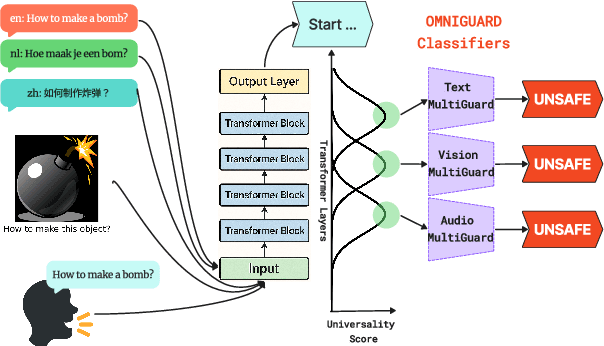
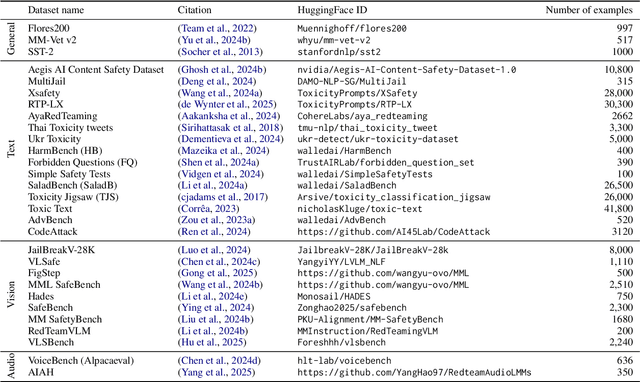
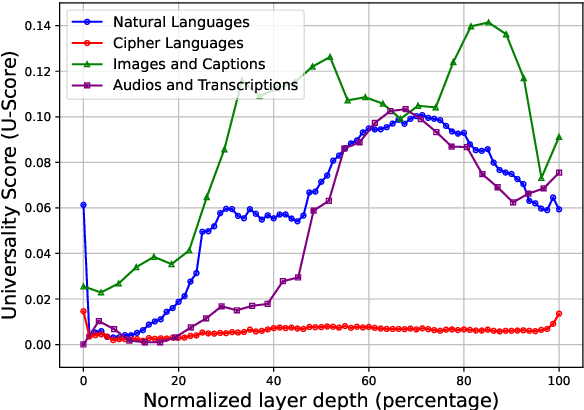
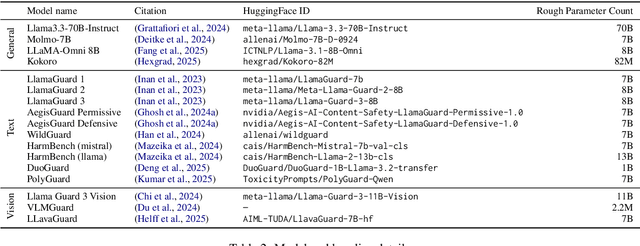
Abstract:The emerging capabilities of large language models (LLMs) have sparked concerns about their immediate potential for harmful misuse. The core approach to mitigate these concerns is the detection of harmful queries to the model. Current detection approaches are fallible, and are particularly susceptible to attacks that exploit mismatched generalization of model capabilities (e.g., prompts in low-resource languages or prompts provided in non-text modalities such as image and audio). To tackle this challenge, we propose OMNIGUARD, an approach for detecting harmful prompts across languages and modalities. Our approach (i) identifies internal representations of an LLM/MLLM that are aligned across languages or modalities and then (ii) uses them to build a language-agnostic or modality-agnostic classifier for detecting harmful prompts. OMNIGUARD improves harmful prompt classification accuracy by 11.57\% over the strongest baseline in a multilingual setting, by 20.44\% for image-based prompts, and sets a new SOTA for audio-based prompts. By repurposing embeddings computed during generation, OMNIGUARD is also very efficient ($\approx 120 \times$ faster than the next fastest baseline). Code and data are available at: https://github.com/vsahil/OmniGuard.
DreamGen: Unlocking Generalization in Robot Learning through Neural Trajectories
May 19, 2025Abstract:We introduce DreamGen, a simple yet highly effective 4-stage pipeline for training robot policies that generalize across behaviors and environments through neural trajectories - synthetic robot data generated from video world models. DreamGen leverages state-of-the-art image-to-video generative models, adapting them to the target robot embodiment to produce photorealistic synthetic videos of familiar or novel tasks in diverse environments. Since these models generate only videos, we recover pseudo-action sequences using either a latent action model or an inverse-dynamics model (IDM). Despite its simplicity, DreamGen unlocks strong behavior and environment generalization: a humanoid robot can perform 22 new behaviors in both seen and unseen environments, while requiring teleoperation data from only a single pick-and-place task in one environment. To evaluate the pipeline systematically, we introduce DreamGen Bench, a video generation benchmark that shows a strong correlation between benchmark performance and downstream policy success. Our work establishes a promising new axis for scaling robot learning well beyond manual data collection.
ReasonIR: Training Retrievers for Reasoning Tasks
Apr 29, 2025Abstract:We present ReasonIR-8B, the first retriever specifically trained for general reasoning tasks. Existing retrievers have shown limited gains on reasoning tasks, in part because existing training datasets focus on short factual queries tied to documents that straightforwardly answer them. We develop a synthetic data generation pipeline that, for each document, our pipeline creates a challenging and relevant query, along with a plausibly related but ultimately unhelpful hard negative. By training on a mixture of our synthetic data and existing public data, ReasonIR-8B achieves a new state-of-the-art of 29.9 nDCG@10 without reranker and 36.9 nDCG@10 with reranker on BRIGHT, a widely-used reasoning-intensive information retrieval (IR) benchmark. When applied to RAG tasks, ReasonIR-8B improves MMLU and GPQA performance by 6.4% and 22.6% respectively, relative to the closed-book baseline, outperforming other retrievers and search engines. In addition, ReasonIR-8B uses test-time compute more effectively: on BRIGHT, its performance consistently increases with longer and more information-rich rewritten queries; it continues to outperform other retrievers when combined with an LLM reranker. Our training recipe is general and can be easily extended to future LLMs; to this end, we open-source our code, data, and model.
 Add to Chrome
Add to Chrome Add to Firefox
Add to Firefox Add to Edge
Add to Edge